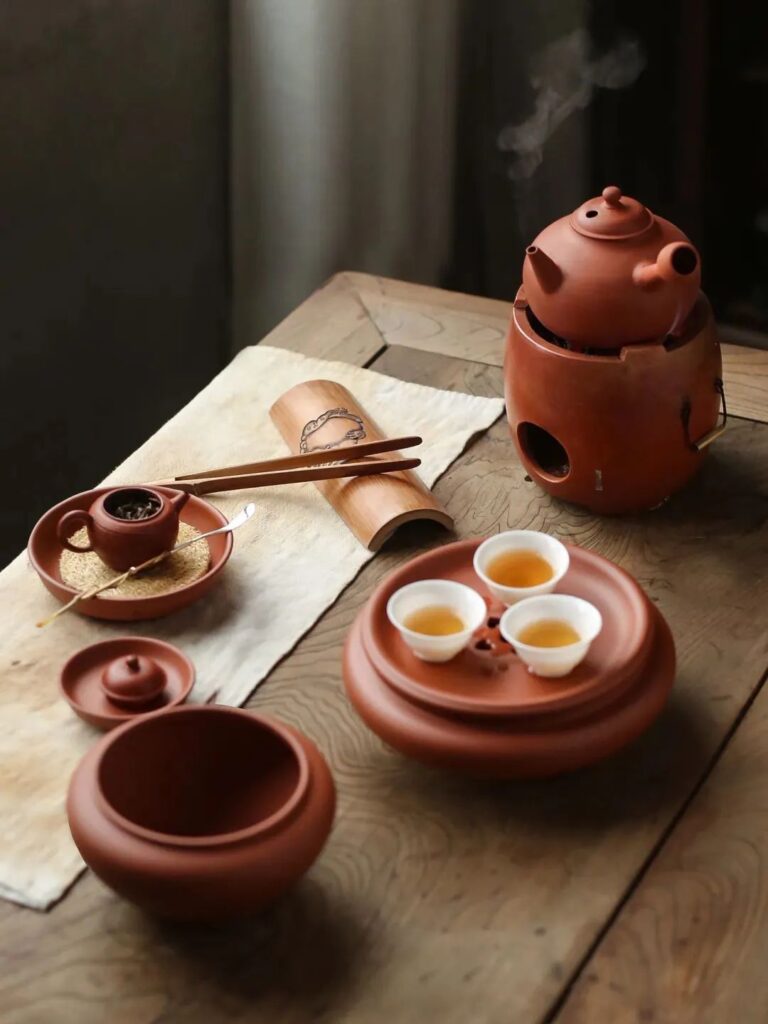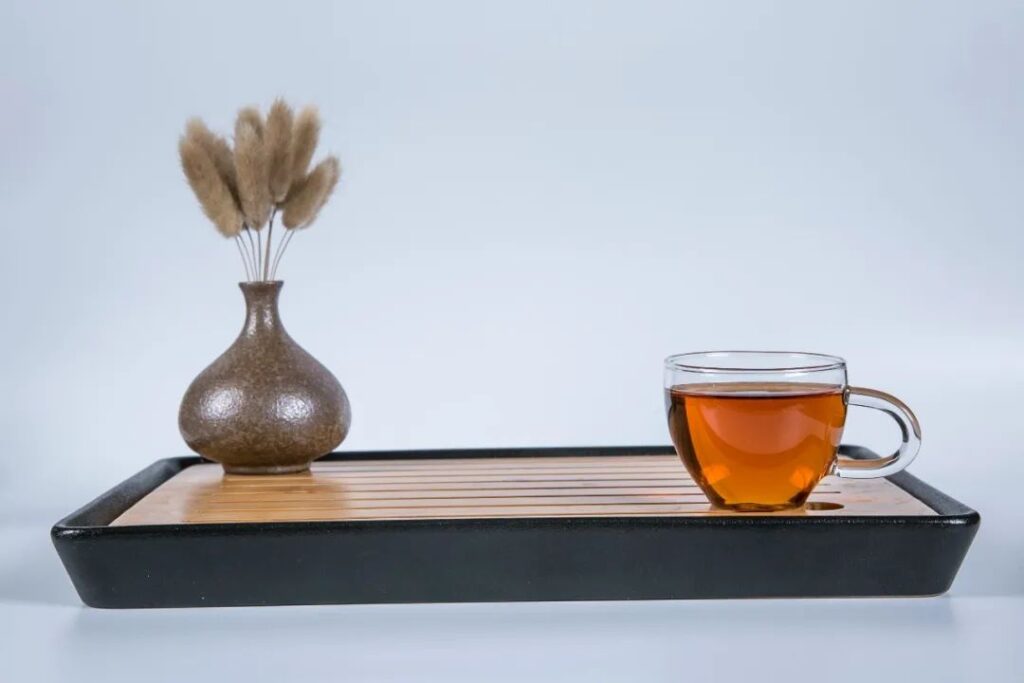Recently, the Xiaodong team initiated a special live broadcast on Guangxi Qinzhou Nixing pottery. A tea enthusiast inquired through the background, “What should be considered when selecting tea brewing utensils?” This is a frequently discussed question. Xiaodong believes that the choice of teaware should primarily depend on the type of tea one wishes to brew. For instance, when brewing Wuzhou Liubao tea, the best partner is the Nixing pottery from the same Guangxi region.
Qinzhou Nixing pottery, along with Jiangsu Yixing Zisha pots, Yunnan Jianshui purple pottery, and Chongqing Rongchang Anfu pottery, are collectively known as the “Four Great Potteries of China,” each with a history of over a thousand years of firing. Local connoisseurs in Wuzhou, Guangxi, often use Nixing pottery pots to brew aged Liubao tea, resulting in a clear and bright soup, with a rich and smooth taste, and an endless aftertaste, making it one of the best tea brewing tools. In fact, such pairings of local pots with local teas reflect the differences in tea-drinking customs across various regions, and the preferred tea utensils also vary accordingly. For example, in areas north of the Yangtze River, covered bowls or large porcelain pots are often used for brewing tea, which can well preserve the tea fragrance. In the Yangtze River Delta region, tea brewing involves not only smelling and tasting but also observing the tea leaves, hence the preference for glass or white porcelain cups. In regions rich in oolong tea production, such as southern and northern Fujian, and Chaozhou in Guangdong, it is customary to sip fragrant oolong tea from small cups. In terms of brewing, Chaozhou Gongfu tea is prevalent, mainly using pots for brewing; Fujian is suitable for both pot and covered bowl brewing. In Sichuan’s Chengdu area, where there are fewer sunny days but many teahouses, people particularly enjoy setting up ‘Longmen Array’ in teahouses to drink covered bowl tea and appreciate the ‘unique’ tea master with a long-spouted pot pouring tea! These are all manifestations of the differences in tea-drinking customs in different regions, leading to distinct choices in tea brewing utensils, which is understandable. Putting this aside, there are thousands of types of tea utensils in the world, but there are still many common points! Generally, the selection of suitable tea brewing utensils mainly starts from the material density, glaze layer, color, shape, and their relationship with tea brewing. The relationship between the material density of tea utensils and tea brewing: The material density of tea utensils has a significant impact on the aroma and taste of the tea soup. The principle is quite simple, which is similar to the kitchen utensils we choose when cooking. For example, when stir-frying green vegetables, it is better to use an iron pan with intense heat and quick stir-frying; if it is a bone soup, it is generally more flavorful to use a sand pot or rice cooker with slow simmering! Generally, tea utensils with high density have low porosity and poor water absorption, such as ceramic covered bowls and silverware, which can be used to brew tea with a lighter style (green tea, black tea, white peony oolong, etc. ). High-density, wide-mouth glass cups are mainly used for brewing tender green tea, yellow tea, white peony silver needle, etc., not only can you smell the overflowing tea fragrance, but you can also watch the graceful unfolding of the tea leaves, and the tea soup is fresh and full when tasted. Tea utensils with low material density have high porosity and large water absorption, good insulation performance, such as Zisha pots can be used to brew fragrant tea, such as Tieguanyin, Wuyi rock tea, Fenghuang single bush, and other high-aroma oolong tea, after brewing, the aroma is mellow and long-lasting.In addition, aged teas that become more fragrant with age, such as aged Liubao tea, old white tea, aged rock tea, and aged Pu-erh tea, are more compatible with purple clay pots that have good airtightness and heat retention. After brewing, they can mellow the aged flavor of the aged tea, which is beneficial to the tea aroma and enhances the tea taste.
The Relationship between the Glaze Layer and Tea Brewing If a pottery with a low density and loose texture is glazed on the inner wall, it will become similar to high-density porcelain and silver tea sets, and can also be used to brew light-tasting teas such as green tea, yellow tea, and new white tea. Unglazed pottery has a high porosity and good adsorption properties, so it is best to brew a specific type of tea. This can not only make the aroma and taste stronger, but also avoid flavor cross-contamination. The Relationship between Color Tone and Tea Brewing The color tone of tea sets includes the color of the material itself and the glaze color of the decoration. For example, white porcelain clay is relatively refined and smooth. To keep it white, a layer of transparent glaze is applied, which is more suitable for pairing with green tea, black tea, and white tip oolong tea. Tea sets made of yellow clay have a higher compatibility with white tea or yellow tea; red clay or gray-brown series fire stoneware clay appears thicker and is more suitable for brewing teas such as Tieguanyin and Dongding Oolong. Tea sets made of purple clay or clay have a simple and natural color tone, and are most suitable for brewing teas with a slightly heavier roasting fire, such as Tieguanyin and Wuyi Narcissus. If the outside of the tea set has a glaze color, it will also affect the type of tea being brewed. For example, light green celadon is more suitable for green tea and lightly fermented oolong tea, and it looks more harmonious visually. There is also a milky white glaze color like “coagulated fat”, which is more suitable for white tea and yellow tea; glaze colors such as iron red, purple gold, and Jun kiln can be paired with Dongding Oolong, Tieguanyin, etc.; darker and blacker glaze colors can be paired with dark teas. The Relationship between the Shape of Tea Sets and Tea Brewing The shape of tea sets mainly affects the speed of heat dissipation during tea brewing and the aesthetics. Generally speaking, tea sets with a wide spout, such as gaiwan and glass cups, have a better heat dissipation effect and are suitable for brewing teas that do not require too high water temperature, that is, teas that emphasize freshness, such as green tea and yellow tea. In addition, gaiwan or glass tea sets with a larger spout are convenient to observe the shape of the tea leaves and the color of the tea soup after brewing, especially for teas that pay attention to the appearance, such as West Lake Longjing, Biluochun, and Junshan Yinzhen. If tea sets of this shape are paired with an appropriate color tone, a better effect will be presented. Purple clay pots and Nixing pottery pots with a “thin spout and narrow spout” are not suitable for brewing green tea. Such a shape has a slow soup pouring time and strong airtightness, and is easy to spoil the tender green tea. Not only will the green tea turn yellow, but the soup will also have a stuffy taste, resulting in a poor tasting experience. Different shapes of tea sets will also affect the tea brewing experience. Purple clay pots with a small spout are prone to clogging when brewing tea, and it is more troublesome to clean the tea dregs, with a high operation difficulty, making them suitable for experienced tea lovers. Gaiwan with a large opening has no trouble of “clogged pot and tilted cup”, is easy to operate, and is more suitable for beginners.In addition, when choosing tea sets, the most important thing to consider is ease of operation and practicality.
If you find that the covered bowl is prone to burning your hands when pouring out the tea soup, using a glass or other tea sets is also acceptable. Of course, the above are just some suggestions when choosing tea sets. So, you who love tea, what kind of tea sets do you like to use? Welcome to leave a message and share your thoughts in the comment section!

